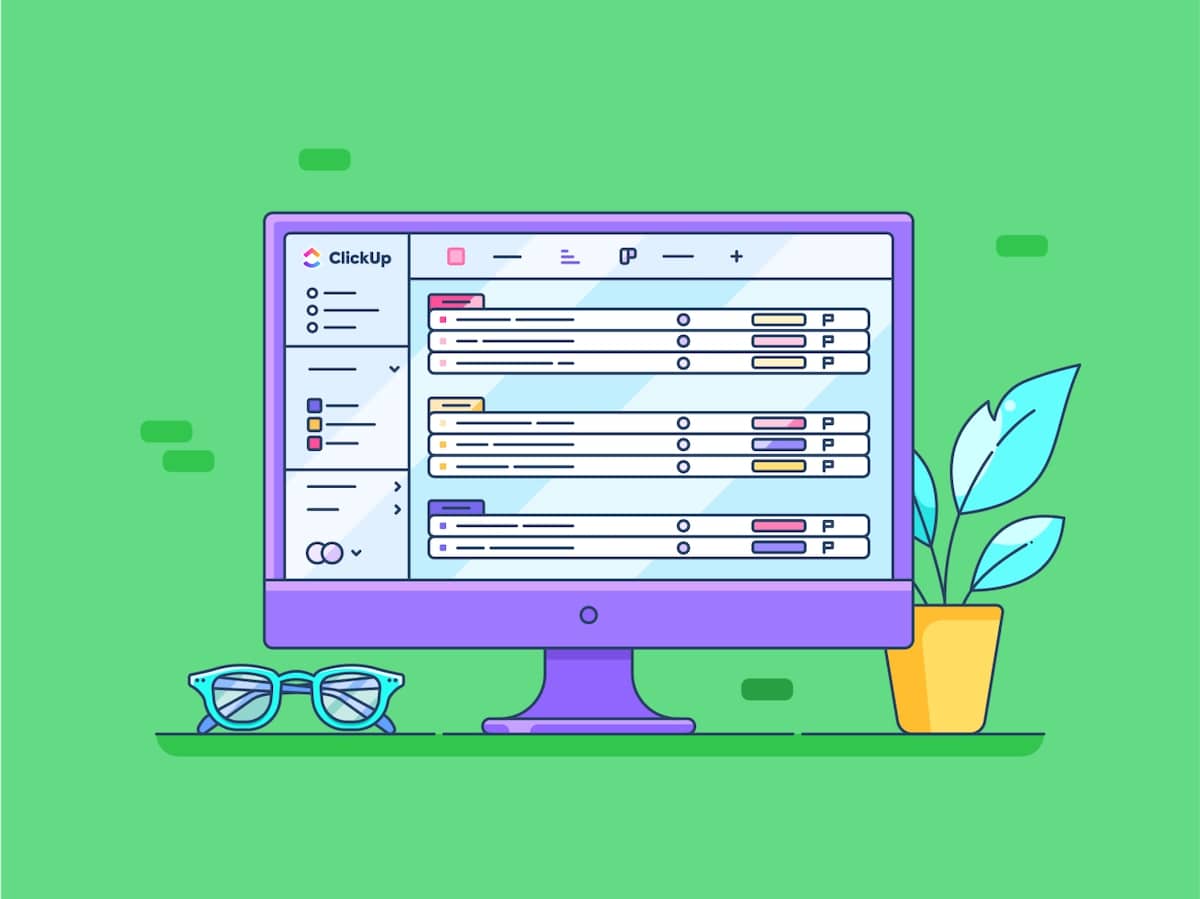هل تساءلت يومًا كيف يبدو أن بعض الأشخاص يتغلبون على قوائم مهامهم دون عناء، تاركين بقيتنا في رهبة من براعتهم في الإنتاجية؟ يبدو أن لديهم عداد الوقت الخاص بهرميوني جرانجر لإنجاز كل شيء بينما نترك نحن في حيرة من أمرنا ونتأمل في أسرار مهاراتهم في تسخير الزمن.
إليكم مراجعة بسيطة للواقع: إنه ليس سحرًا - بل مجرد استراتيجية.
كل إنسان عجيب فائق الإنتاجية لديه سلاحٌ خارق في معركته ضد الفوضى والتسويف: قائمةالأولويات_!
اكتشف قوة الخمسة مع دليلنا الشامل لصياغة قائمة أولويات فعالة. سنقدم لك خمسة أسباب مقنعة، ونرشدك خلال خمس خطوات بسيطة، ونكشف لك خمس طرق متقدمة - كلها مصممة للارتقاء بحياتك الشخصية والمهنية! 🏋️
ما هي قائمة الأولويات، وما هو الغرض منها؟
قد تظن أنك تعرف ما هي قائمة الأولويات - قائمة لتنظيم المهام على أساس الأهمية والإلحاح (_duh!) ولكن هناك المزيد لتفكيكها هنا من منظور إنساني.
خذ مثلاً الكتاب المؤثر، قائمة الأولويات: السعي الأخير لمعلم لاكتشاف أعظم دروس الحياة على سبيل المثال. وهو عبارة عن مذكرات مقنعة لديفيد ميناشي، وهو مدرس لغة إنجليزية في مدرسة ثانوية يواجه سرطان الدماغ في مراحله الأخيرة. في رحلته الشجاعة في جميع أنحاء البلاد، يسعى إلى إعادة التواصل مع طلابه السابقين، مدفوعًا بسؤال عميق: هل أحدث فرقًا في حياتهم؟
تكشف رحلة ديفيد كيف أن شغف المرء ودوافعه غالباً ما تؤثر على أولوياته في أي مرحلة من مراحل حياته. ووجهة نظرنا هنا هي أنك إذا رتبت أولويات مهامك بشكل صحيح، يمكنك التركيز على ما يهمك.
لا يتعلق الأمر فقط بتقليل التوتر و
زيادة الإنتاجية
ولكن أيضًا حول محاربة المشتتات حتى تتمكن من تعزيز أهدافك الأساسية. وتتمثل الخلاصة الرئيسية في أن تقول _نعم للمهام التي تدفعك إلى الأمام و لا لتلك التي تستنزف وقتك.

## 5 أسباب لإنشاء قائمة أولويات
في ظل فوضى المهام الكثيرة جدًا، فإن تعلم كيفية تحديد الأولويات ليس خيارًا - بل هو حاجة غير قابلة للتفاوض. لذا، دعونا نتحدث عن سبب أهمية ذلك وكيف يجعل وقتنا مهمًا وسط جداول أعمالنا المزدحمة.
1. نظّم مهامك ضمن الوقت المتاح
هل شعرت يومًا أن هناك الكثير من المهام التي عليك القيام بها والوقت المتاح قليل جدًا، ولكنك لست متأكدًا من أين تبدأ؟ هنا يأتي دور ترتيب الأولويات.
من خلال تدوين ما يجب القيام به وإعطاء كل مهمة مستوى أولوية، فأنت تقول بشكل أساسي: هذه هي الأشياء الكبيرة، وهذه هي الأشياء غير الكبيرة، حيث تتيح لك القائمة الموضوعة بعناية إدارة وقتك مثل الرئيس، مما يضمن لك أن تكون ليس فقط مشغولاً ولكن مشغولاً بالأشياء المهمة حقًا.
2. زيادة الإنتاجية
تُعد زيادة الإنتاجية سببًا آخر مقنعًا لإنشاء قائمة أولويات، حيث تساعدك على التركيز على المهام ذات القيمة العالية التي تدفعك نحو تحقيق أهدافك. ستجد أن القائمة المنظمة بشكل جيد يمكن أن تحسين يوم عملك اليومي مما يساعدك على تحقيق المزيد في وقت أقل.
إليك كيف تعمل قائمة الأولويات عادةً على زيادة إنتاجيتك:
- الوضوح: تعمل القائمة على فرز مهامك، مما يمنحك صورة واضحة لما تحتاج إلى معالجته - فأنت لا تضيع الوقت في المداولات بل تتخذ إجراءات ملموسة
- التركيز بالليزر : من خلال عزل المهام ذات التأثير العالي، يمكنك تركيز جهودك حيثما كانت أكثر أهمية
- تعزيز التحفيز : يمكن أن يكون إنجاز المهام مرضيًا للغاية ويشجع على اتخاذ المزيد من الإجراءات
- تخفيف التوتر: قائمةتقدم خارطة طريقوتقليلالقلق بشأن نسيان المهام أو تفويت المواعيد النهائية
3. تبسيط الأهداف
إذا كان تحقيق الهدف مثل الوصول إلى قمة جبل، قائمة أولوياتك هي الخريطة المؤدية إلى القمة. ⛰️
تتضاعف القائمة كخطة قابلة للتنفيذ تحوّل التطلعات إلى انتصارات من خلال محاذاة المهام والعمليات اليومية مع الأهداف ذات الصورة الكبيرة. يضمن لك أن تكون كل خطوة تخطوها هادفة ومدفوعة بالتقدم في سياق أهدافك الشخصية والمهنية.
نصيحة إضافية: يعاني الكثير من الأشخاص من مشكلة التركيز على هدف معين، مما يضعف من جودة قائمة أولوياتهم. إذا كنت واحدًا منهم، ننصحك باستخدام ClickUp Goals لتصور الرئيسي الخاص بك النواتج وتحديد ما يجب تحديد أولوياته.

قسّم الأهداف والمهام والنقاط الرشيقة وحالات المشروع في لوحة معلومات ClickUp 3.0 القابلة للتخصيص بدرجة كبيرة
4. تتبع تقدم الأهداف
من خلال تحديث العناصر المكتملة ووضع علامات عليها باستمرار، فإنك تجعل من قائمة أولوياتك أمين سجل لإنجازاتك في الوقت الفعلي. فهو يوفر لك وضوحًا بشأن ما تم إنجازه، وما هو قيد الإنجاز، وما هو قيد التنفيذ، وما هو التالي، مما يلغي التخمين ويسمح لك بالاحتفال بكل إنجاز وتحديد مخاطر الإنجاز مسبقًا.
5. رسم خريطة لتبعيات المهام
أنت تعرف كيف أنه في بعض الأحيان يتعين على إحدى المهام انتظار انتهاء مهمة أخرى؟ هذا هو تبعية المهمة . إنها في الأساس سلسلة من الأحداث المترابطة التي تساعد قائمة الأولويات على تصورها. عندما تفهم كيف تعتمد المهام على بعضها البعض، يمكنك أن تكون ذكيًا بشأن ما يجب معالجته أولاً. تعد قائمة الأولويات مهمة بشكل خاص في بيئة الفريق، حيث يمكن أن يؤدي انتظار المهام التابعة إلى تأخيرات غير متوقعة (وغالبًا ما تكون مكلفة).
يمكنك استكشاف كيف تعمل تبعيات المهام داخل ClickUp مما يسمح بتدفق العمليات بسلاسة دون توقف غير ضروري!

قم بتعيين ترتيب واضح للعمليات من خلال إضافة تبعيات "الحظر" أو "الانتظار" بين المهام وإبقاء فريقك على المسار الصحيح لمعرفة ما يجب العمل عليه أولاً
كيفية إنشاء قائمة أولويات: 5 خطوات عملية
الأهداف، سواء كانت كبيرة أو صغيرة، هي أول همسات الحلم، ولكن تحويلها إلى واقع يتطلب أكثر من مجرد التمني. لقد حان الوقت لوضع القلم على الورق، أو الأفضل من ذلك وضع الأصابع على لوحة المفاتيح، وإعطاء هيكلية لتلك التطلعات.
سنناقش الخطوات الخمس لإنشاء قائمة أولويات وظيفية - وسنوضح العملية من خلال انقر فوق
لنقم بترقية تلك الأولويات وتبسيطها والتغلب عليها!
الخطوة 1: قم بتجميع قائمة مهام رئيسية
قبل أن تتمكن من تحديد الأولويات، ستحتاج إلى وضع قائمة بجميع المهام التي تحتاج إلى إكمالها. قد تشعر بالارتباك في البداية، ولكن إليك بعض النصائح لتبسيط مهامك:
- اكتب كل شيء: من الأعمال الروتينية البسيطة إلى المسؤوليات الملحة، أخرج كل شيء من نظامك
- لا تحكمي أو تحللي: لا تنزل إلى وضع التحليل والتحليل فقط دع أفكارك تتدفق بحرية
- قم بتضمين المهام الشخصية: لا يجب أن تقتصر قائمة أولوياتك على مهام العمل إذا كنت تهدف إلىتحقيق التوازن بين العمل والحياة الشخصية
- تحديث: عند ظهور أعمال جديدة، قم بإضافتها إلى قائمتك الرئيسية للحفاظ على تنظيم المهام
- كن محددًا: من الصعب معالجة المهام الغامضة (مثل "تخصيص الموارد"). إضافة أكبر قدر ممكن من التفاصيل (مثل "تخطيط تخصيص الموارد للقسم أ للربع الثالث") يساعدك على تحديد المهمة وتنفيذها بدقة
نوصي بتدوين المهام على منصات رقمية مثل ClickUp، فصدق أو لا تصدق أن الملاحظات اللاصقة أو القوائم الورقية المجعدة ستجعل الأمور غير منظمة في المستقبل.
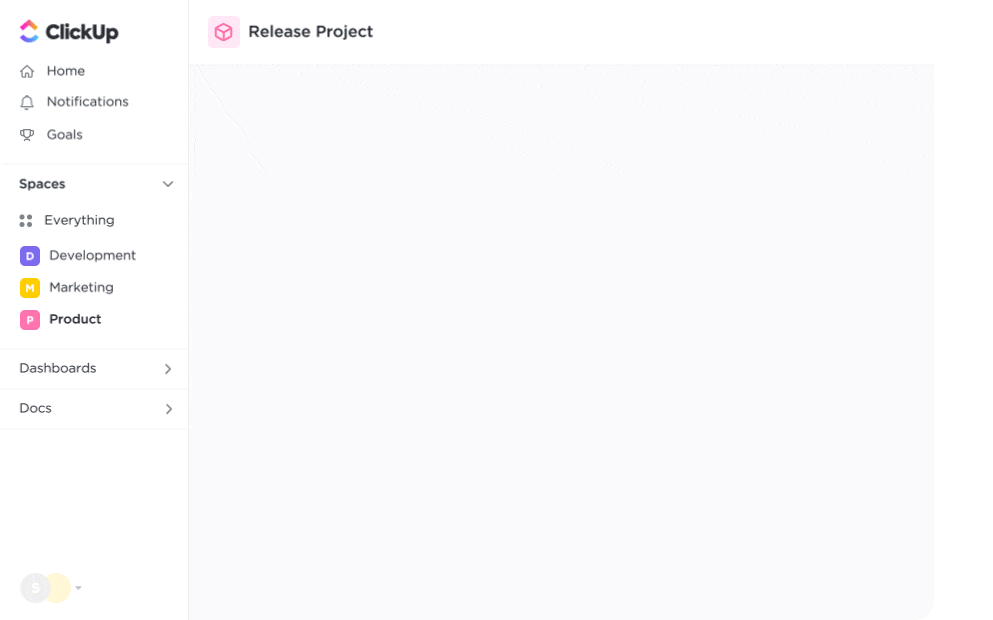
استخدم ClickUp لإنشاء قوائم أولويات مرمزة بالألوان، وإكمال المهام والمشاريع، والتعاون بكفاءة مع فريقك
أصبح إنشاء قوائم المهام على أي نطاق أمرًا في غاية السهولة مع مجموعة إدارة المهام من ClickUp . تأتي مع مجموعة واسعة من الميزات لمساعدتك:
- إعداد المهام (أو تقسيمها إلى مهام فرعية محددة)
- إضافة المكلفين بالمهام لإنشاء المساءلة
- تخصيص تواريخ الاستحقاق لتخطيط الأولويات العالية
- أتمتة المهام المتكررة في قائمتك باستخدامأتمتة ClickUp
- وسم مهامك لسهولة التعرف عليها (لمساعدتك في تحديد الأولويات في الخطوة 2)
قم بتعديل وتخصيص قائمتك الرئيسية باستخدام ClickApps لعمليات مثل إضافة معرّفات مهام مخصصة أو العلاقات داخل عمليات سير العمل ! إذا كنت تنشئ قائمة أولويات لفريق كبير، فاستخدم الميزات التعاونية مثل التعليقات المترابطة والإشارات لتطلب من زملائك المساهمة في أنواع المهام. 🧑🤝🧑

عزز الوضوح عبر مشاريعك من خلال أنواع المهام القابلة للتخصيص وحسّن التنظيم عبر جهود إدارة مهامك
الخطوة 2: تحديد المهام ذات الأولوية القصوى
تخيل مهامك كشخصيات في مسرحية، لكل منها دوره وتأثيره على قصة يومك. بعضها شخصيات رئيسية فائقة الأهمية، في حين أن البعض الآخر شخصيات داعمة تنتظر دورها. تدور هذه الخطوة حول تحديد هذا التسلسل الهرمي.
يمكن أن يكون تعيين مستويات الأهمية للمهام أمرًا سهلاً مع انقر فوق أولويات المهام . مع وجود أربعة مستوياتعاجلة، وعالية، وعالية، وعادية، ومنخفضةلديك المرونة الكافية لتحديد ما تعنيه كل حالة أولوية مرمزة بالألوان لفريقك. 🚩
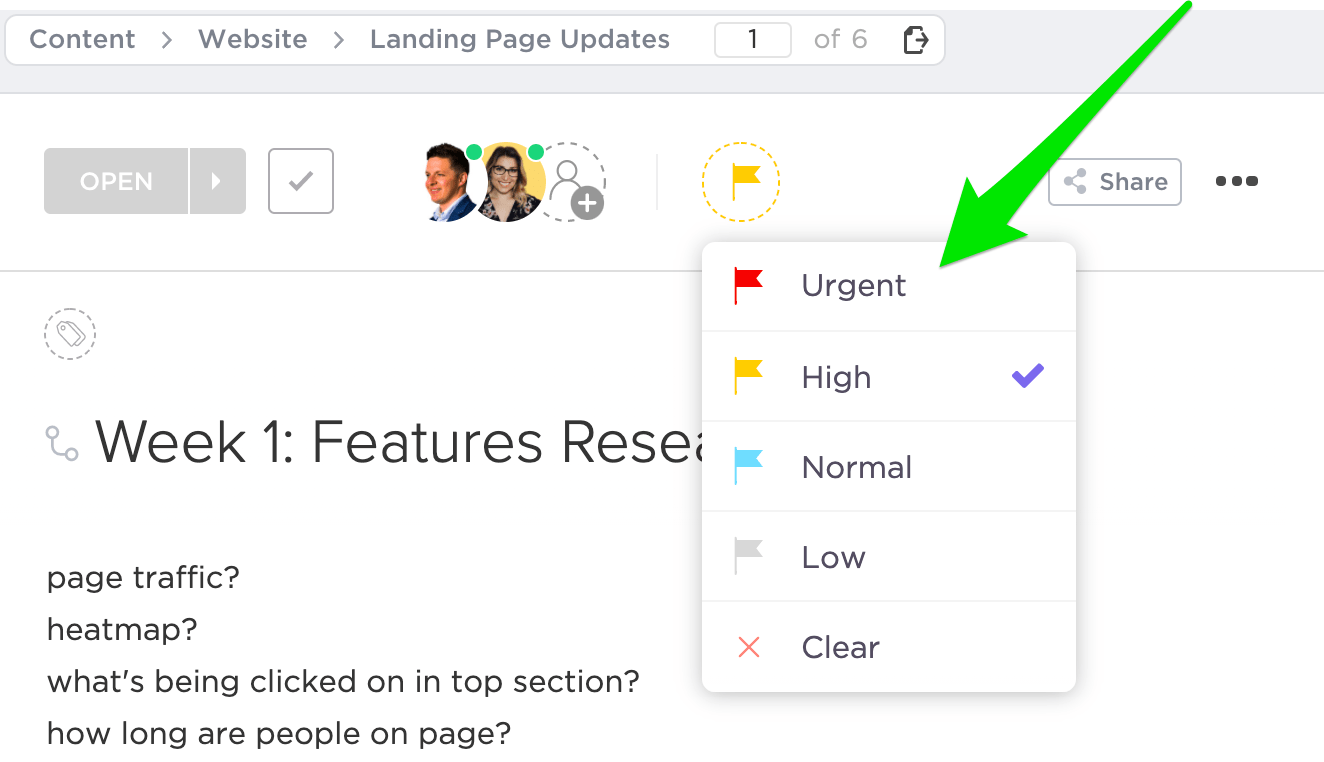
تحديد أولويات المهام في ClickUp للتمييز بشكل أفضل بين ما يجب القيام به الآن وما يمكن تأجيله
لتحديد الأولويات في مساحة العمل الخاصة بك، يمكنك التبديل بين مختلف طرق عرض ClickUp لاستكشاف وجهات نظر مختلفة. إليك ثلاثة أمثلة:
- عرض المهمة: افتح مهمة، وانقر ببساطة على أيقونة العلم الموجودة في الزاوية العلوية اليسرى من نموذج المهمة لتعيين أولويتها
- عرض القائمة: توجد أيقونة علامة الأولوية على يمين كل مهمة
- عرض اللوحة: مرر الماوس فوق الزاوية السفلية اليسرى لبطاقة المهام للوصول إلى خيارات الأولوية
بمجرد الانتهاء من إعداد أولويات المهام وتواريخ الاستحقاق، استخدم الخيار عرض التقويم للإشراف على جدولك الزمني أو تصفية المهام ذات الأولوية أو تعديلها بشكل مجمّع.

تعيين أولوية المهمة بسرعة داخل مهمة ما لتوصيل ما يحتاج إلى الاهتمام أولاً
الخطوة 3: تفويض المهام بكفاءة إلى أعضاء الفريق الفرديين
غالبًا ما ينتهي الأمر بمديري الفرق بقوائم مهام ضخمة تؤدي إلى الإرهاق. بدلاً من محاولة القيام بكل شيء بمفردك, فكر في التفويض المهام بناءً على مهارات أو خبرات الموظفين الفردية و تعزيز كفاءة العملية . 🔀
لنفترض أن لديك عضو في الفريق، نيك، الذي يبرع في التصميم الجرافيكي. والآن، لديك مهمة ذات أولوية قصوى تتضمن إنشاء عرض تقديمي مقنع من أجل إطلاق منتج جديد ويتطلب درجة معينة من التصميم.
هنا يمكنك هنا تحديد الأولويات بشكل أفضل من خلال التفويض - بدلاً من التعامل مع العرض التقديمي بأكمله بمفردك، يمكنك الاستعانة بخبرة نيك في التصميم الجرافيكي. وبهذه الطريقة، تكون قد خففت العبء عنك وضمنت أن تكون المهمة في أيدٍ أمينة.
يعد تفويض المهام ذات الأولوية في ClickUp أمرًا سهلاً للغاية باستخدام ميزة التذكيرات . إذا كنت ترغب في مشاركة عبء العمل، فأنشئ مهمة، واستخدم الخيار مفوض لاختيار زميل في الفريق، لنقل نيك، وقم بإعداد التذكير بتاريخ استحقاق ومرفق أو تعليق يحتوي على تعليمات المهمة.

قم بإعداد التذكيرات بسهولة باستخدام الأمر "R" في ClickUp
الخطوة 4: حذف المهام غير الضرورية
نعم، لقد قرأتها بشكل صحيح. يمكن أن يكون حذف المهام من قائمتك الرئيسية عملاً محررًا في السعي لتحقيق الإنتاجية. هذا مدعوم بـ تقرير اتجاهات التعلم في مكان العمل لعام 2021 مما يشير إلى أن المهام غير الأساسية يمكن أن تكون عوامل ضغط مشروعة على الفريق.
لإعادة تقييم الأولويات في قائمة مهامك، اسأل نفسك: هل هذه المهمة ضرورية للغاية؟ إذا لم يكن الأمر كذلك، فاضغط على زر الحذف دون تردد. 🗑️
لا تتعلق هذه الطريقة بتجنب المسؤولية بل بالتنظيم الاستراتيجي. من خلال التخلص من المهام غير المهمة - فكر في الاجتماعات وورش العمل وما إلى ذلك - فإنك تقوم بإزالة الفوضى من قائمتك، مما يفسح المجال للعمليات المهمة.
هل تريد مناقشة المهام التي يجب التخلي عنها مع فريقك؟ إن قالب خطة العمل الذكية ClickUp SMART يمكن أن يساعد الموظفين على تصنيف المهام على أنها مممحددة، مقابلة للتحقيق، ممممكنة، صمذات صلة، ممناسبة ، مناسبةللوقت، مما يساعد على التخلص من الأعمال ذات القيمة المنخفضة.
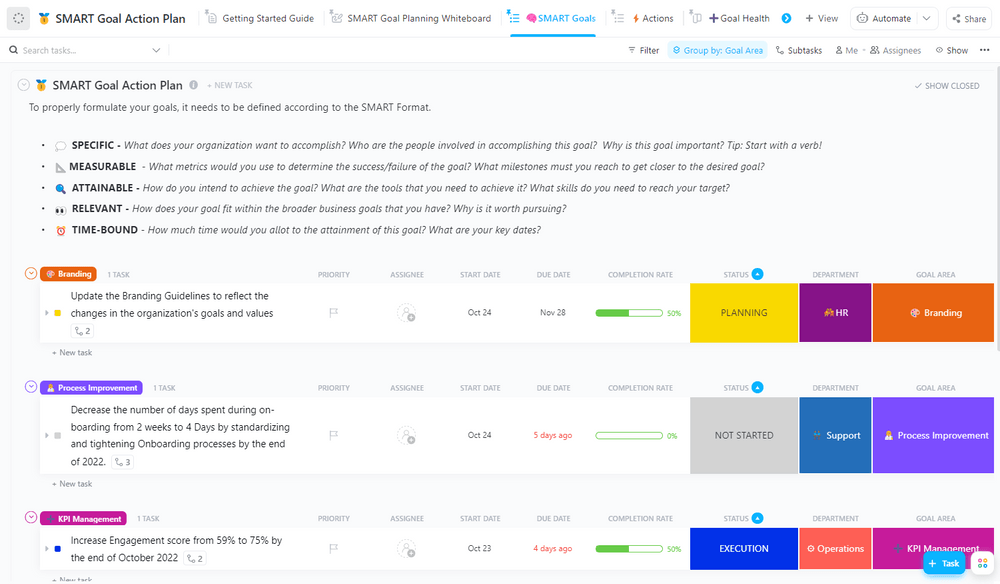
باستخدام قالب خطة عمل الأهداف الذكية SMART، يمكنك ضمان متابعة أهدافك من خلال عرض مرئي للقائمة لإبقاء كل شيء منظمًا وعلى المسار الصحيح
/ctaBtn/الأخضر https://app.clickup.com/signup?template=kkmvq-6080788 تنزيل هذا القالب /%ctaBtntn/
الخطوة 5: التحقق والتتبع وإعادة الزيارة
عندما تنتهي من مهمة ما، ضع علامة اختيار بجانبها. فكلما زاد عدد علامات التحقق، زاد تحفيزك على إنجاز بقية يومك. بدلاً من ذلك، يساعد التتبع أيضًا في تعديل قوائم الأولويات حسب الحاجة. ✅
إذا كنت ترغب في تحديد أنماط عملك لـ تحسين تدفقات المهام استخدام الأصلي تتبع الوقت داخل ClickUp . لنفترض أن تستغرق العملية باستمرار وقتًا أطول أكثر مما تتوقع. باستخدام بيانات تتبع الوقت، يمكنك اكتشاف الأطر الزمنية غير الواقعية مسبقًا وتعديل قائمة أولوياتك بشكل استباقي.
![]()
إنشاء جداول زمنية ومراقبة الوقت الذي تم تتبعه في ClickUp
## 5 طرق لتحديد الأولويات يجب عليك تجربتها
للارتقاء ببراعتك في إدارة المهام، دعنا نتعمق في خمس طرق متقدمة وذكية لتحديد الأولويات.
1. التصنيف على أساس الوقت
بمجرد تجميع قائمة المهام الضخمة، قم بتقسيمها وتصنيفها حسب الحاجة. تتضمن الاستراتيجية الشائعة التصنيف على أساس الوقت. ما عليك سوى تجميع المهام حسب الوقت الذي تخطط لإنجازها فيه - سواء اليوم أو هذا الأسبوع أو هذا الشهر أو ما بعده - لتقييم معايير الأولوية. 🗓️
2. طريقة المهام الأكثر أهمية (MITs)
إن طريقة المهام الأكثر أهمية هي وسيلة لتغيير قواعد اللعبة لاستعادة السيطرة عندما تغرقك قائمة المهام الشاقة. فبدلاً من الانشغال بقائمة شاملة، يمكنك أن تختار بشكل استراتيجي أهم مهمتين أو ثلاث مهام - أي أهم مهامك لليوم. 📑
تصبح هذه المهام ذات الأولوية القصوى مركز تركيزك، مما يسمح لك بالتخلص من المشتتات المحتملة. أنت تضمن إنجاز المهام وتخلق نهجًا يركز على الليزر الذي يمكن أن يمتد إلى إنجاز عناصر إضافية في قائمتك. استخدم علبة المهام الخاصة بـ *ClickUp's Task Tray للحفاظ على سهولة الوصول إلى ملفات MIT اليومية.

يمكنك تبسيط يومك بإضافة مهام ذات أولوية إلى علبة مهام ClickUp
3. طريقة التركيز الفردي
بالنسبة للأوقات التي تشعر فيها بأن المهام الأكثر أهمية (MITs) أكثر من اللازم، فإن هذا الأسلوب يأخذ الأمر خطوة إلى الأمام. إنه التبسيط المطلق - اختر مهمة واحدة، ذات أولوية مطلقة، ودع كل شيء آخر يتلاشى في الخلفية. 🧘
تخيل صباح يوم اثنين محموم مع قائمة مهام تمتد إلى ما لا نهاية. تشعر بثقل المهام العديدة، فتستخدم طريقة التركيز الواحد. وبإلقاء نظرة خاطفة على قائمتك، تحدد مشروعًا مهمًا - ربما عرضًا تقديميًا للعميل يتطلب انتباهك الكامل.
طوال فترة الصباح، تلتزم فقط بتنقيح هذا العرض التقديمي طوال فترة الصباح، مع إبعاد ضجيج المهام الأخرى التي تتنافس على انتباهك. وبحلول منتصف النهار، تكون قد أنهيت العرض التقديمي بأكمله بنجاح.
النتيجة؟ لقد حوّلت هذه الطريقة ما كان يمكن أن يكون يومًا مبعثرًا ومرهقًا إلى يوم من الإنجاز المستهدف.
4. مصفوفة أيزنهاور لتحديد الأولويات
إذا كنت عالقًا في معضلة _ما الذي يجب التركيز عليه أولاً، فإن مصفوفة أيزنهاور حليفك. هذه التقنية عبارة عن تصنيف بسيط وفعال للمهام بناءً على مدى إلحاحها وأهميتها، وتقسيمها على أربعة أرباع. 🪟
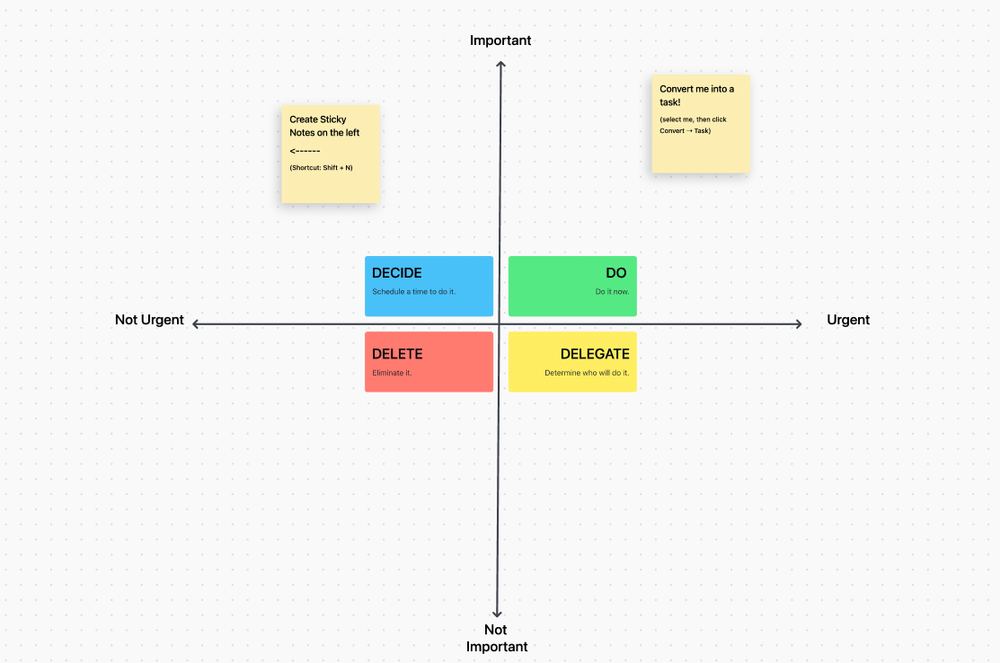
قم بفرز قوائم المهام الضخمة بسهولة باستخدام قالب مصفوفة أولويات أيزنهاور من ClickUp
كل ما عليك فعله هو رسم المحورين الأولوية و الأهمية. الآن، ضع المهام في الفئات التالية:
- عاجل و مهم: قم بها
- عاجل و غير مهم: قم بجدولتها
- غير عاجل ولكن غير مهم: قم به: قم بتفويضها
- ليست عاجلة و ليست مهمة: قم بها: احذفها
مكافأة: جرّب مجاناً قالب مصفوفة أولويات ClickUp لإعداد تقرير أولويات سريع قائم على الشبكة! تحتوي المنصة أيضًا على العشرات من قوالب تحديد الأولويات يمكنك استكشاف
/ctaBtn/الأخضر https://app.clickup.com/signup?template=kkmvq-6322890 تنزيل هذا القالب /%ctaBtntn/
5. طريقة أكل الضفدع
تخيل قائمة المهام الخاصة بك على أنها بركة مليئة بالمهام، وهناك ضفدع عملاق وشاق في داخلها - وهي مهمة تفضل تجنبها. والآن، _كل هذا الضفدع! خدعة براين تريسي يقترح عليك أن تغوص وتعالج تلك الضفدعة الكبيرة في الصباح الباكر لبناء الزخم.
الأمر أشبه بقولك: لننتهي من الأمور الصعبة بينما نحن منتعشون ومستعدون للانطلاق، وبقيامك بذلك، فأنت لا تكتفي فقط بإنجاز مهمة صعبة بل تهيئ الأجواء ليوم مليء بالانتصارات. لذا، أحضر قهوتك وخذ نفسًا عميقًا ودعنا نأكل تلك الضفدعة! 🐸
كن سيّد تحديد الأولويات مع ClickUp
قائمة أولوياتك ليست مجرد قائمة - إنها خطة لعبتك للنجاح. من خلال تخطيط يومك بشكل استراتيجي، يمكنك تجنب الاندفاع في اللحظة الأخيرة وتفويت المواعيد النهائية.
أنجزها وأنجزها بشكل صحيح مع ClickUp! ثق بهذا الكل في واحد أداة تحديد أولويات العمل لمساعدتك في تصنيف الأعمال وتفويضها وتحديد أولوياتها دون عناء. اشترك لاستكشاف اختصاراتها للفوز! 🏆
